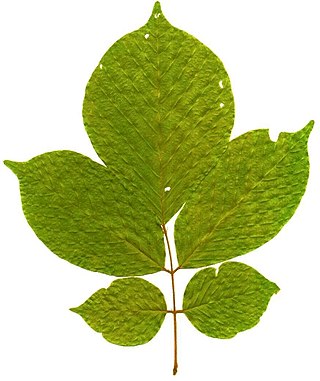
Millettia laurentii is a legume tree from Africa and native to the Republic of Congo, the Democratic Republic of Congo, Cameroon, Gabon and Equatorial Guinea. The species is listed as "endangered" in the IUCN Red List, principally due to destruction of its habitat and over-exploitation for timber. Wenge, a dark coloured wood, is the product of Millettia laurentii. Other names sometimes used for wenge include faux ebony, dikela, mibotu, bokonge, and awong. The wood's distinctive colour is standardised as a "wenge" colour in many systems.
Millettia aurea is a species of plant in the family Fabaceae. It is found only in Madagascar.

Millettia is a genus of legume in the family Fabaceae. It consists of about 150 species, which are distributed in the tropical and subtropical regions of the world. The genus was formerly known by the name Pongamia, but that name was rejected in favor of the name Millettia, and many species have been reclassified. Due to recent interest in biofuels, Pongamia is often the generic name used when referring to Millettia pinnata, a tree being explored for producing biodiesel.
Millettia bussei is a species of plant in the family Fabaceae. It is found in Mozambique and Tanzania.
Millettia conraui is a species of plant in the family Fabaceae. It is found in Cameroon and Nigeria. It is threatened by habitat loss.
Millettia eriocarpa is a species of plant in the family Fabaceae. It is found only in Tanzania.
Millettia galliflagrans is a species of plant in the family Fabaceae. It is a tree endemic to Peninsular Malaysia. It is threatened by habitat loss.
Millettia lacus-alberti is a species of plant in the family Fabaceae. It is found in Democratic Republic of the Congo and Uganda.
Millettia macrophylla is a species of plant in the family Fabaceae. It is found in Cameroon, Equatorial Guinea, and Nigeria. Its natural habitat is subtropical or tropical moist lowland forests. It is threatened by habitat loss.
Millettia micans is a species of plant in the family Fabaceae. It is found only in Tanzania.

Millettia mossambicensis is a species of plant in the family Fabaceae. It is endemic to central Mozambique, where it is fairly widespread in the low-lying woodlands and forests. The small trees are over-exploited for local construction purposes.
Millettia nathaliae is a species of plant in the family Fabaceae. It is found only in Madagascar.
Millettia orientalis is a species of plant in the family Fabaceae. It is found only in Madagascar.
Millettia richardiana is a species of plant in the family Fabaceae. It is found only in Madagascar.
Millettia sacleuxii is a species of plant in the family Fabaceae. It is found only in Tanzania.
Millettia schliebenii is a species of plant in the family Fabaceae. It is found only in Tanzania.
Millettia semseii is a species of legume in the family Fabaceae. It is endemic to Tanzania. It has been assessed as "vulnerable" in the IUCN Red List.
Millettia sericantha is a species of plant in the family Fabaceae. It is found only in Tanzania.
Millettia unifoliata is a species of legume in the family Fabaceae. It is a tree endemic to Peninsular Malaysia. It is threatened by habitat loss.
Millettia warneckei is a species of plant in the family Fabaceae. It is found in Ghana, Guinea, Liberia, Sierra Leone, and Togo. It is threatened by habitat loss.


